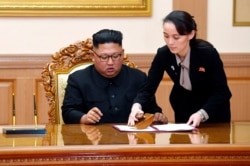North Korea has followed through on its threat to demolish the de facto inter-Korean embassy just north of the border, Pyongyang’s latest move to ratchet up tensions with Seoul.
South Korean media reported a loud explosion and smoke Tuesday near the Kaesong industrial complex, which houses the inter-Korean liaison office. A few minutes later, Seoul’s Unification Ministry, which handles inter-Korean relations, confirmed the building had been blown up.
North Korean state media also confirmed that the facility was destroyed by what it called a "terrific explosion."
Though the destruction of the liaison office is a blow to Seoul, the move was primarily symbolic, since the office had been nonfunctional for months. South Korean staff left the facility in late January due to coronavirus concerns.
Over the past week, North Korean officials had repeatedly threatened to destroy what they called the “useless” office, which was set up in 2018 as part of a series of agreements meant to improve cooperation and dialogue between the two Koreas.
North Korea is ostensibly angry at South Korea for not doing more to stop defectors and other activists from floating anti-Pyongyang leaflets and other materials across the border. Pyongyang has dismissed Seoul’s aggressive steps to stop the leaflet launches and ban such activity. Instead, the North has threatened a series of retaliatory steps.
“This is a staged provocation cycle rather than a one-off response to NGO leaflets,” says Leif-Eric Easley, a professor at Ewha University in Seoul. “The Kim regime is also signaling the United States won't have the luxury of keeping North Korea on the back-burner for the remainder of the year.”
Push for concessions
North Korea has a long history of periodically ramping up tensions in order to extract economic and other concessions from the South. Currently, Pyongyang is frustrated that Seoul has been unwilling to push ahead with improving inter-Korean ties.
In 2018, North Korean leader Kim Jong Un and South Korean President Moon Jae-in held three meetings, where they agreed to reduce tensions, expand dialogue, and interact economically.
But implementation of those deals has been complicated by international sanctions over North Korea’s nuclear program. The United States has been unwilling to relax the sanctions unless North Korea agrees to give up its entire nuclear program.
By threatening South Korea, the North appears to be using Seoul to pressure Washington over the stalled nuclear negotiations. The North Korean provocations may also be designed to increase tensions between the U.S. and South Korea.
Rejected offers
South Korea’s left-leaning government, which is newly empowered following a sweeping legislative election win in April, has vowed to explore every avenue to improve ties with its northern neighbor.
But North Korea has for months rejected every South Korean offer. Instead, Kim Jong Un’s sister, Kim Yo Jong, this month has flung repeated insults and threats at Seoul.
“We should not lend an ear to and trust the trite language let out by them for only form’s sake as they always make a fuss belatedly, nor pardon the sins committed by the betrayers and human scum,” Ms. Kim said earlier this week.
Domestic motivations
The episode has helped burnish the domestic and international political credentials of Ms. Kim, who has taken on a dramatically larger leadership role in recent months.
The provocations may also be an attempt to unify public opinion in North Korea, amid coronavirus concerns.
North Korea, a tightly controlled quasi-Stalinist state that does not allow spontaneous protests, has allowed several recent demonstrations against the leaflet launches.
More to come?
North Korean officials have also repeatedly hinted at a series of unspecified military action against the South, though it’s not clear how far Pyongyang is willing to go.
In a statement Tuesday, North Korea’s military suggested it was preparing to re-enter parts of the border area that had been disarmed under the inter-Korean agreements.
“Our army is on high alert to ensure a military guarantee for any external measures to be taken by the Party and the government,” read the statement, published in the state-run Korean Central News Agency.
Past provocations
North Korea has a long history of deadly military provocations against the South. In March 2010, a North Korean torpedo sank a South Korean warship off Korea’s west coast, killing 46 sailors. A few months later, the North shelled the border island of Yeonpyeong, killing several more people.
Tuesday’s liaison office destruction falls far short of those steps, says Duyeon Kim, a senior adviser for Northeast Asia and nuclear policy at the International Crisis Group.
“It’s technically not an attack on South Korea nor an act that would invite a military response from Seoul,” she says. “We can expect Pyongyang will continue with similar military acts but not enough that would force Seoul to retaliate in kind with force.”







